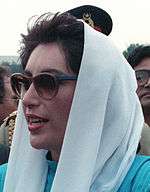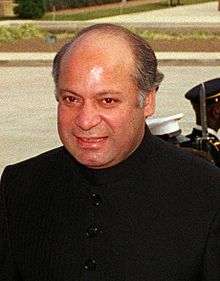Pakistani general election, 1988
| | ||||||||||||||||||||||||||||||||||||||||||||||||
| ||||||||||||||||||||||||||||||||||||||||||||||||
| ||||||||||||||||||||||||||||||||||||||||||||||||
| ||||||||||||||||||||||||||||||||||||||||||||||||
 |
| This article is part of a series on the politics and government of Pakistan |
| Constitution |
|
The Pakistani General elections of 1988 were held in Pakistan on 16 November 1988 to elect the 336 members and 100 Senators to the Pakistan Parliament. The Pakistan Peoples Party, led by Benazir Bhutto, ousted and disintegrated the technocratic and military government of General Zia-ul-Haq, with the parliamentary majority of 94 seats. The election was the second of four non-consecutive victories for the Pakistan Peoples Party, and Benazir became Pakistan's – and the Muslim world's— first female head of government.
The previous parliamentary elections were held on 7 March 1977, with the Peoples Party gaining two-thirds majority. However, amid violence and civil disorder, Chief of Army Staff General Zia-ul-Haq ousted the former Prime minister Zulfikar Ali Bhutto in a military coup d'état, code-named Operation Fair Play. Martial law was uplifted in 1985 when the non-political and technocratic elections were held in 1985. As a result Mohammad Junejo, a Sindhi lord, was appointed Prime minister; he was soon dismissed by General Zia and after Zia's death new parliamentary elections were finally held. Previously, General Zia had crushed the socialists' Movement for the Restoration of Democracy, who had attempted to overthrow his military regime, and took extremely tough actions to further disintegrate the movement.
After Zia's death, the democratic socialists and secular parties re-united and campaigned under the Pakistan Peoples Party's platform led by Benazir Bhutto. The Pakistan Peoples Party campaign pledged to control and tackle the extremism in Pakistan, and as well as curb the power of the trade unions. The conservatives under Nawaz Sharif on other hand campaigned upon expanding the industrialisation and privatisation program; the liberals Muttahida Qaumi Movement (MQM) boycotted the elections.
The result was a victory for the Pakistan People's Party, which won 94 of the 207 seats. Voter turnout was 43.5%.[1] Benazir Bhutto became the eleventh Prime minister, and Sharif took the office of Leader of Opposition in 1988. . Results for the election were broadcast live on the PTV and presented by Mumtaz Hamid Rao, Tariq Aziz, Hamid Mir and Dr. Anita Raja.
Background
On 29 May 1988, the National Assembly which was elected in 1985 was dissolved prematurely by President Mohammad Zia-ul-Haq dismissing the Prime Minister and the rest of his cabinet asserting that the 'administration was corrupt and inefficient'. The new polling date (exceeding the limit of 90 days following dissolution laid down by the Constitution of Pakistan) was set by the President on 20 July 1988. Moreover it was also announced that the elections would be held on a non-party basis.[2]
However, on 2 October, following the accidental death of President Zia on 17 August, the Supreme Court of Pakistan reversed the ban on parties and allowed the elections to be held on a party basis.
Parties
The Pakistan People's Party (PPP), led by Benazir Bhutto and the conservative Islamic Democratic Alliance (IJI), headed by Nawaz Sharif, as well as a huge number of other groups, fielded around 1,370 candidates for the 237[3] seats of the assembly. The campaign lasted for a month and remained generally peaceful.[2]
Results
Despite allegations of vote rigging against the PPP, and the use of the ID card rule to keep its less well-organized and relatively less well-off supporters from voting, Bhutto won the election by a margin of over 8%, thus managing to defeat the nine-party alliance of IJI.
| Party | Votes | % | Seats |
|---|---|---|---|
| Pakistan People's Party | 7,546,561 | 38.5 | 94 |
| Islami Jamhoori Ittehad | 5,908,741 | 30.2 | 56 |
| Pakistan Awami Ittehad | 848,119 | 4.2 | 3 |
| Awami National Party | 409,555 | 2.1 | 2 |
| Jamiat Ulema-e-Islam (Fazl-ur-Rehman) | 360,526 | 1.8 | 7 |
| Punjabi Pakhtun Ittehad | 105,061 | 0.5 | 0 |
| Pakistan National Party | 104,442 | 0.5 | 0 |
| National Peoples Party (Khar) | 97,363 | 0.5 | 1 |
| Pakistan Democratic Party | 80,743 | 0.4 | 1 |
| Balochistan National Alliance | 59,248 | 0.3 | 2 |
| Pakistan Muslim League | 55,052 | 0.3 | 0 |
| Pakistan Milli Awai Ittehad | 46,562 | 0.2 | 0 |
| Jamiat Ulema-e-Islam (Darkhasti) | 44,964 | 0.2 | 1 |
| Tehrik-e-Jafaria (Arif Hussaini) | 42,261 | 0.2 | 0 |
| 15 other parties | 51,656 | 0.3 | 0 |
| Independents | 3,829,705 | 19.5 | 40 |
| Invalid/blank votes | 313,926 | – | – |
| Total | 19,904,440 | 100 | 207 |
| Source: Nohlen et al. | |||
Aftermath
In light of these results, the acting President Ghulam Ishaq Khan invited the PPP to form a government. The PPP formed the Government making alliances with small parties and independent groups. On 4 December 1988, Benazir Bhutto was elected as the first female Prime Minister of a Muslim country. The new Cabinet, headed by Prime Minister was subsequently announced.[2]
References
- ↑ Dieter Nohlen, Florian Grotz & Christof Hartmann (2001) Elections in Asia: A data handbook, Volume I, p678 ISBN 0-19-924958-X
- 1 2 3 Pakistan: Elections held in 1988 Inter-Parliamentary Union
- ↑ Pakistan Elections 2008 | Pakistan Elections 2013. Elections.com.pk. Retrieved on 3 August 2013.

